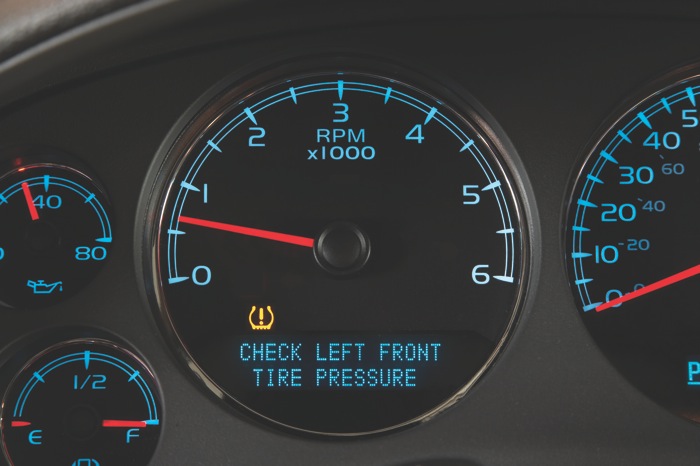Indirect Tire Pressure Monitoring Systems (TPMS) are the systems that don’t have air pressure sensors inside the tires. Rather, they detect a low tire by comparing relative wheel speeds via the Anti-lock Brake System (ABS) wheel speed sensors. When a tire loses air, its diameter decreases slightly.
Older indirect TPMS are not as sensitive to changes in tire pressure as direct systems that actually monitor the air pressure inside the tire, but they are not as expensive either. An indirect TPMS is a relatively affordable add-on to a vehicle if it’s already equipped with ABS. Even so, the vast majority of vehicles that have TPMS use direct systems rather than indirect.
Federal law requires the TPMS to alert the driver if the pressure inside a tire has dropped more than 25% below the recommended inflation pressure. The same rules apply to direct and indirect TPMS. Many vehicle manufacturers abandoned indirect systems for direct systems to meet the federal mandate.
One of the weaknesses of older indirect systems is that they may not turn on the warning light if all the tires are underinflated by a similar amount. If the recommended pressure is 32 psi, but if all the tires are 24 psi (down 25%), the system won’t know there’s a problem because all the tires will be rotating at the same speed when the vehicle is being driven.
New systems are taking advantage of better wheel speed sensors and modules to make indirect systems work. Indirect TPMS began making a comeback in 2011 on all Audi models. The highly popular Honda Accord switched to indirect TPMS for the 2013 model year. The 2013 Mazda CX-5 is now also using an indirect TPMS. Some of the VW Golf platform vehicles have switched to an indirect TPMS. Most of these models have the optional ABS and stability control system.
But even the newer systems suffer from the inability to read the tire pressure when the vehicle is sitting still.
INDIRECT TPMS APPLICATIONS
- Audi 2011-2014
- BMW X5 2002-2005
- Buick LeSabre 2000-2005
- Buick Lucerne 2006
- Buick Park Avenue 1998-2005
- Buick Regal 1999-2004
- Buick Rendezvous 2003-2007
- Chevy Impala 2000-2005
- Chevy Monte Carlo 2000-2005
- Ford Freestar 2004-2005 (some also have direct TPMS)
- Ford Windstar 2001-2003
- Honda Accord 2013-2014
- Lexus LS430 2004-2006
- Lexus RX330 2004-2006
- Mazda CX-5 2013-2014
- Mercedes C-Class 2007
- Mercedes SLK 2005-2007
- Mercury Monterey 2004-2005 (some also have direct TPMS)
- MINI Cooper 2004-2007
- Oldsmobile Alero 1999-2000
- Oldsmobile Aurora 2001-2003
- Pontiac Aztec 2003-2005
- Pontiac Bonneville 2000-2005
- Pontiac Grand Am 1999-2002
- Pontiac Grand Prix 2004-2006
- Pontiac Vibe 2005-2007
- Toyota Corolla 2005-2007
- Toyota Matrix 2005-2006
- Toyota Solara 2004-2006
- Toyota Highlander 2004-2006
- Toyota RAV4 2004-2005
- Volkswagen GTI 2007 and 2010
- Volkswagen Jetta 2005-2007
WHERE TO FIND RESET PROCEDURES
All of these applications use a similar technology and strategy to detect a low tire, but there is no common reset procedure. Toyota is probably the best, with only one simple reset procedure for all of its indirect TPMS (though a slightly different procedure is used on the Lexus models).
With so many different reset procedures, it’s important to make sure you’re using the right procedure for the vehicle you’re servicing.
TPMS reset procedures may also be found in the vehicle owner’s manual (if it hasn’t been lost). Open the glove box and check the index in the owner’s manual for any TPMS information.
AUDI RESET PROCEDURES
Find the factory tire pressure specifications on the placard located on the doorsill on the driver’s side.
Identify the tire that is low on pressure and fill it up according to factory specifications.
Put the key in the ignition and start the car, but don’t turn the engine on.
Push the “Car” button located on the vehicle control panel.
A menu will pop up on the screen, scroll down and select “tire pressure monitoring.”
Select “Store Curr. Tire Pressure”
The screen will then read, “tire pressures are being stored.”
The tire pressure light should now be reset.
TOYOTA
On Toyota applications, the reset procedure is fairly straightforward, though it actually takes much longer to complete. Turn the key on (engine off), then press and hold the RESET button until the flashing TPMS warning light goes off. Or, if it is not flashing, hold the RESET button until the light flashes three times. Turn the key off.
Hold on though: The relearn procedure is not complete until the vehicle is driven at 19 mph or faster for at least an hour. You don’t have to do this, obviously, but your customer should be made aware of the fact that the TPMS reset procedure won’t be complete until the car has been driven awhile. During this time, the TPMS system may not be able to detect a low tire, so make sure all the tires have been inflated to the correct pressure before the vehicle leaves your shop.














